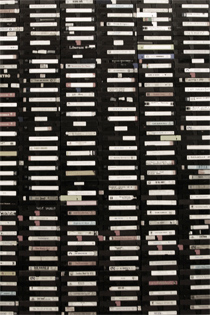Sébastien Nageleisen | 20.01.2014
The crossing of the Aubrac plateau is very much appreciated by all hikers/pilgrims going to Santiago de Compostela. This paper uses a collection of pictures as scientific material to study the landscape on offer along this route. Landscapes are described and then compared in order to identify the specificities of the crossing of the Aubrac and beyond and, more generally, to understand how cultural routes transcend landscapes and vice versa. In this original spatial experience, various walking rhythms are [...]
Berger, Mathieu, Daniel Cefaï et Carole Gayet-Viaud (dirs.). 2011. Du civil au politique. Ethnographies du vivre-ensemble. Bruxelles : Peter Lang, coll. « Action publique ».
Consuelo Biskupovic | 13.01.2014
This article analyzes the different ways of conducting ethnographic investigations that are proposed in the book Du civil au politique. Ethnographies du vivre-ensemble by Mathieu Berger, Daniel Cefaï and Carole Gayet-Viaud. Firstly, it examines the authors’ choices : the ethnographic method as well as the relationship between political and civil activities can be found in each article. Secondly, it discusses the commitments and central propositions of the book. It shows how the authors reconcile a pragmatic perspective with an [...]
Le cas du col du Coq et de la Dent de Crolles dans le massif de Chartreuse (France).
Yohann Rech et Jean-Pierre Mounet | 07.01.2014
The organization of outdoor sports areas is an important issue because athletes are not the only ones to invest nature. This article discusses the management of outdoor sports activities in a part of the Chartreuse Regional Nature Park (France). The latter has a particularly complex network with different managers, different political scales and varied sports and traditional activities. An analysis of the intentional management and effective management of the site (Mermet 1994) shows that the prerogatives of the managers [...]
| 17.12.2013
In the streets of their cities, Koreans are replacing their old maps with a new digital representation of urban space, revealing the massive societal changes underway in the land of new technology. These moves, including the promotion of the “smart city”, provide a convenient angle from which to consider the switch from the old industrial cities in decline to the new information cities on the rise. A new system is being born, drawing in the major part of the [...]
Régimes d’historicité et individus contemporains.
Jacques Lévy | 17.12.2013
Among the interviews conducted in Geneva, general and abstract speeches on the future are rare. This does not prove that the future is absent from discourses and imaginations ; it could mean that the tools we use do not enable us to detect it. The “No future !” motto only informs us that historicist myths have collapsed. Meanwhile, projects have taken place. By and large, this can be explained by the increase of lifespan time scale degrees of freedom [...]
Virginie Milliot | 10.12.2013
L’Art sur la Place and the parade closing the Biennale de la Danse in Lyon can be considered as participative art happenings, designed to welcome the cultural diversity of the city. Several analyses and critiques presented these events as “political shams” or as “rituals of urban areas”. By using a corpus of data collected in the course of long term participant observations, I propose to reopen the debate about the political consequences of these projects. In order to analyse [...]
Céfaï, Daniel (dir.). 2010. L’engagement ethnographique. Paris : Éditions de l’École des Hautes Études en Sciences Sociales.
Virginie Tallio | 25.11.2013
Cet ouvrage dirigé par Daniel Céfaï réunit différents articles traduits de l'anglais qui illustrent chacun une facette de l'enquête ethnographique. Ils sont introduits par un article, écrit par un auteur à chaque fois différent, qui situe leur contexte historique et théorique ainsi que leur portée dans les débats actuels, que ce soit dans le monde anglophone ou francophone. Ce livre souhaite insister sur l’importance de l’ethnographie, une méthode qui touche tous les chercheurs en sciences sociales. Il réhabilite les [...]
Anne-Laure Amilhat Szary | 19.11.2013
À partir d’œuvres d’art contemporain produites autour du mur construit par les Israéliens face à la Cisjordanie, le texte traite à la fois de la question de la traversée de la frontière et des normes qu’il faut affronter pour passer la ligne, ainsi que du processus de résistance active que ce passage implique. Par son rapport très particulier au lieu, le « border art », ou « art de la frontière », questionne les processus de spatialité à travers [...]
Conférence/performance, 9’49, 2011
Éric Valette | 19.11.2013
Illustrated conference performance, on the basis of a historic timeline of Cyprus. 35° north/34° east is the location of the small section of the beach enclosed in the buffer zone that divides the island in two, just below the closed city of Famagusta. This city was the starting point of a collective project, Suspended Spaces, in the context of which 35°Nord 34°Est was realized in response to the importance of the readings and representations of history in a conflict [...]
Alexandre Rigal | 12.11.2013
Urban space is sometimes said to be irrepresentable. However, many representations and images make it comprehensible. These forms and images are spreading in our daily lives and in scientific practices through various technological tools. Trying to understand these fragmentary or reductive and totalizing representations challenges the definition of urban space. Beyond traditional representations and metaphors that deny the plurality of urban actors and objects, this article offers an intuitive survey of the representation of urban cities, of urban space [...]


